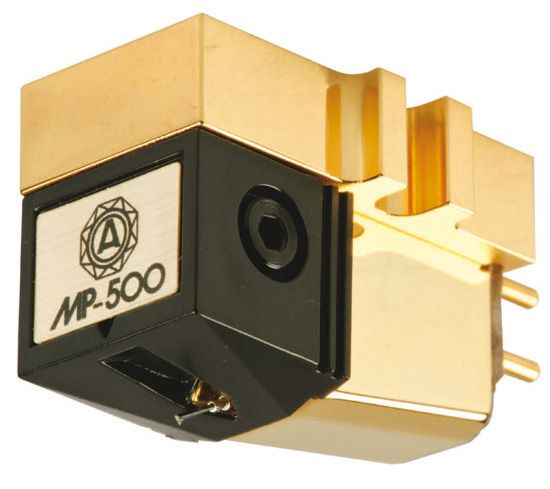Nagaoka Mp 500 (£450)

It’s easy to forget that movingcoils were once the minority cartridge choice (not least because the best of them were low-output types needing complicated step-ups). For most hi-fi enthusiasts, moving-magnets ruled.
In between MMs and MCs were other types: variluctance, movingflux – with Nagaoka providing, with its ‘Moving Permalloy’, one of the more successful alternatives to straight MM operation. Common to all, or nearly all, non-MCs was a higher output that would work with the standard 47kohm phono input then prevalent. Among the hottest of the day were Nagaoka’s least expensive models, which must have fed tens of thousands of NAD3020s via Duals ‘back in the day’.
This wholly modern flagship Nagaoka appears to be the 21st century’s answer to the original MP-50, with only an extra zero and new stylus carrier colour to distinguish between them. Their basic architecture is identical, including a large, flat top surface and parallel sides to aid alignment, and the cartridge features ruggeder-than-thou bolts to hold the replaceable stylus in situ.
Apart from an increase in the manufacturer’s stated output – the MP-50’s was 2.5mV, whereas the MP-500’s is specified as 3.0mV – these two cartridges are nearly identical. Line-contact stylus on a boron cantilever, solid body, samarium cobalt magnet, carbon fibre reinforced plastic ‘shoe’ for the stylus assembly … and nothing about this cartridge presents many problems either for tonearms or standard phono inputs.
Tested with the MM stage in the McIntosh C2200, and via NAD PP2 and Audio Research PH5 phono amps, gain was never an issue. Tonearm cable and phono stage capacitance offer some latitude for tweaking, although with the 100pF loading or less suggested by the Editor, treble remained sweet and sharp, without rolling off or turning sibilant. Arms tried included the Linn Ekos on the LP12, and the SME Series V on the SME 30/12.
BALANCING ACT
Set-up was painless and tracking force ideal at 1.5g (the middle of the manufacturer’s recommended range), the MP-500 never showing a hint of mistracking. If anything emerged that was even marginally related to a caveat, it was the balancing act between classic moving-iron/magnet levels of retrieval of detail and squeakyclean sound versus a tendency to exaggerate highs on certain LPs.
To ensure VTA was not an issue, we stayed with identical-thickness LPs during the tests. It soon became clear that this was far less critical than capacitance loading, but we’re talking about splitting hairs. A cluster of LPs by both The Band and Little Feat, all of which possess sophisticated, syncopated rhythms, found the Nagaoka able to deliver the kind of textured, tactile lower registers normally associated with the richness of Koetsus and the like, but the snap and decay had a different character.
It may have been over-damping or a slight removal of warmth, but it was not enough to reprove the Nagaoka. If anything, it added to a sense of modernity from a cartridge that, more than once, provided flashbacks of 1979. Vocals offering some ‘shout’, such as the chorus on Little Feat’s breathtaking ‘Oh, Atlanta!’, backed by a tight section with percussive keyboards and a swampy rhythm section, remained distinct and individual even within the mass of harmony.
With the recent Yep Roc releases of a trio of Nick Lowe albums, the Nagaoka demonstrated that it is not mired in the 1970s. If the costlier Linn Arkiv MC had more warmth and greater stage depth, the Nagaoka could match or exceed it in areas such as transient attack and bass control. Which you’d prefer is where personal taste enters…
VERDICT
Nagaokas were always better than ‘merely competent’, and this latest model throws the hat into the current analogue-revival ring with panache. It will certainly appeal to listeners with preamps lacking gain for MCs, and will surely mate beautifully with vintage units of the Radford SC22/McIntosh C22 variety. It also bears a sane price tag.

























































